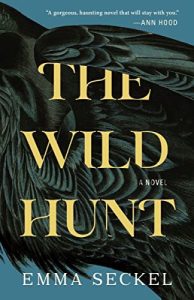Reviewed by Jesse Mullins

In her debut novel The Wild Hunt, Emma Seckel delivers a fascinating blend of historical fiction and the supernatural to create a wonderfully mysterious drama. Set in post-WWII Scotland, protagonist Leigh Welles returns home to her small town after the unexpected death of her father, only to find the island is not quite as she remembers it. Unsurprisingly, the war has taken its toll on the community, leaving many families to pick up the pieces of their modest lives. The brunt of the difference, however, is felt with the Sluagh, creatures from Celtic legend that inhabit the island. These creatures, which appear as crows, instill a sense of fear and superstition in the remote island. While these crows appear every October, they’ve become more numerous and violent in recent years. As the story progresses, Leigh and another citizen, Iain, are drawn into a mystery involving the disappearance of a boy in town, forcing her to explore the island and its history.
At best, Seckel delivers an incredibly compelling setting and cast of characters in this suspenseful drama. The finite confines of the island itself are used to great effect, creating a distinct feeling of isolation for both Leigh and the reader. By the end of the book, the island feels ready to burst at the seams and fly away like the Sluagh described therein. Every worn street and misty moor feel simultaneously lived-in and eerie, a feeling I relished during my reading.
The characters, as well, are masterfully written. Each one is multi-faceted and truly lifelike. Every character has discernable feelings, motivations, and regrets, and the gritty, almost cynical tone of many of the islanders contrasts perfectly with Leigh’s rough determination. The novel shines during the emotionally charged conversations between Leigh and her estranged brother, or between her and Iain, a young veteran of the war struggling to find direction now that he’s home. These two relationships in particular highlight how well Seckel grapples with fundamental ideas like moving on past hardship and finding direction. These ideas are explored through sharp, efficient dialogue that leaves your heart lurching in the best way. At the core of every character is their relationship to family, giving the entire cast of characters, and indeed the island itself, satisfying thematic unity.
I was primarily drawn to this book because I was intrigued by the combination of historical fiction and supernatural elements. I was curious to see how the story would balance these competing ideas between grounded realism and folklore superstition, and I can comfortably say I was satisfied. The historical setting feels incredibly grounded, and these two features, superstition and war, are utilized well to analyze complex issues like guilt, loss, the devastation of war, and the alluring pull of folklore and tradition. This is particularly observable in sections centered around Iain, where Seckel uses his perspective to highlight the impact of the recent war on the town and its residents, including the numerous sons and daughters who didn’t make it back. Through Leigh’s eyes, we compare the island of today to the island of her childhood, inviting us to disentangle the truth behind the island’s qualities from the warping of time and innocence. In this way, Seckel further explores the depth of her characters, including their biases, regrets, and mistakes to ensure they come across as genuinely relatable.
It should be noted that this will likely appeal most to readers that favor slow-burn suspense, as this novel’s investigation into the island is taken one step at a time. Seckel takes her time exploring the characters, scenery, and history of the island in intimate fashion. Though the buildup is indeed lengthy, the time is used quite effectively to carefully craft her setting. By the end of the book, I felt as though I could have traced a map in the sand of that very island, if not one similar, and I felt a quiet longing for a place I had never been. Further, Seckel mostly uses the supernatural elements of her story as a tool to heighten existing drama, rather than the sole focus. Fitting the aesthetic and scenery, its implementation often feels like a whispered message just out of sight: unsettling, yet leaving you deeply intrigued.
This book is perfect for anyone with a love for historical fiction and mysteries, particularly given that the book is laid out in a fashion that truly makes it difficult to put down at times. Seckel is adept at providing cliffhangers at the end of many chapters that feel earned, demonstrating her skill with pacing. If you’re like me, then when you put this book down, you will be pondering questions of family, loss, and the traditions that tie us together.
